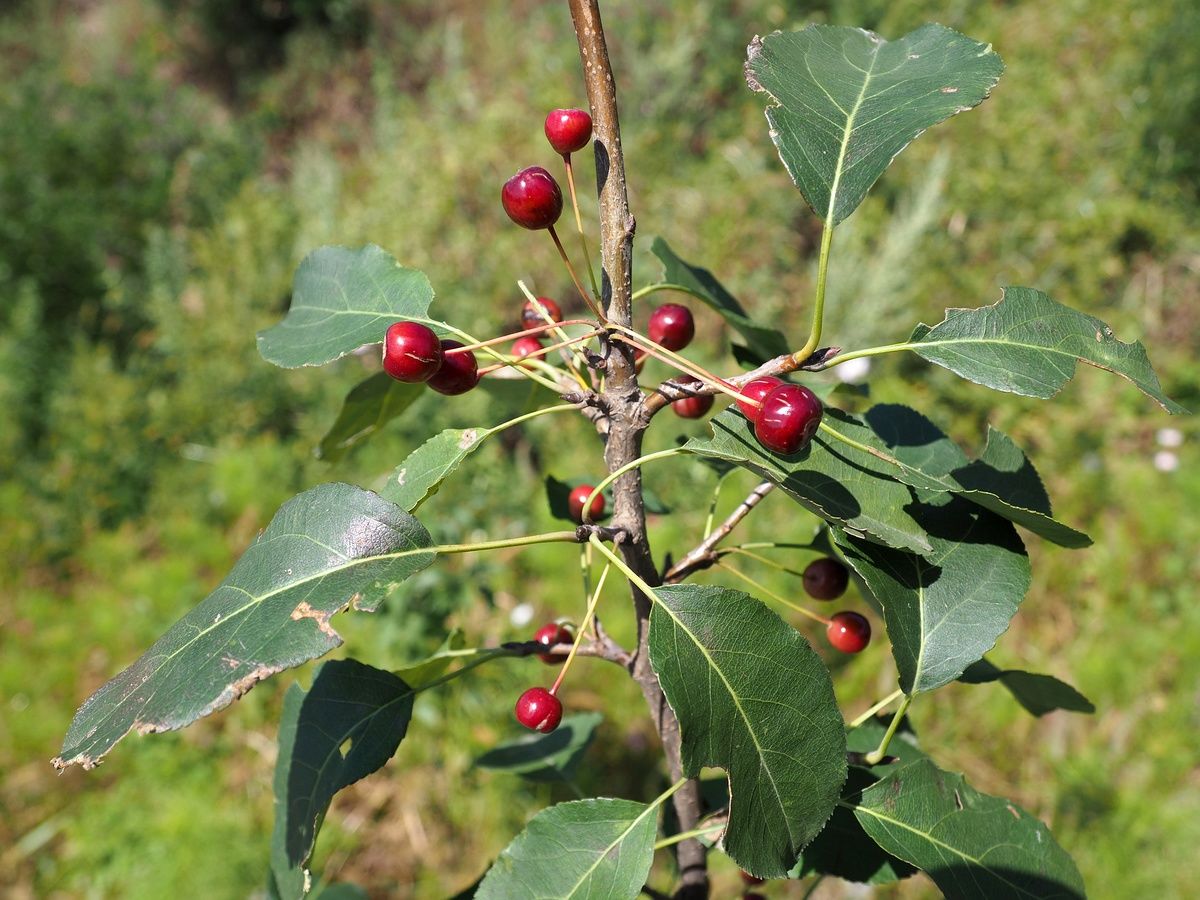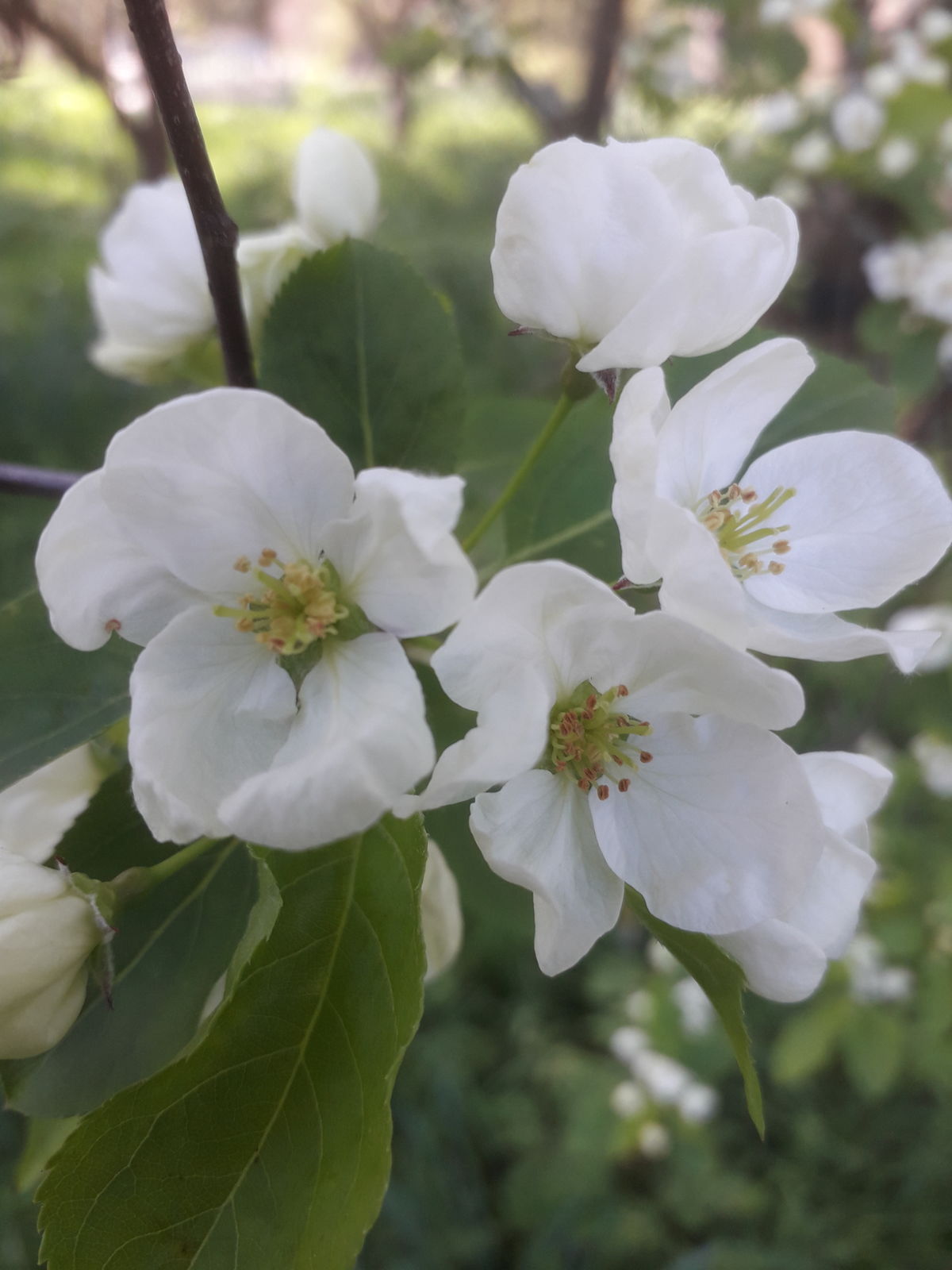Family: Rosaceae
Author: (L.) Borkh.
Bibliography: Theor. Prakt. Handb. Forstbot. 2: 1280 (1803)
Year: 1803
Status: accepted
Rank: species
Genus: Malus
Vegetable: False
Observations: Siberia to Korea and Himalaya
Description
Siberian crab, scientifically known as Malus baccata, is a deciduous fruit-bearing tree that belongs to the Rosaceae family. It is native to a broad geographical range extending from the cold expanses of Siberia to the temperate regions of Korea and the majestic landscapes of the Himalayas. Known for its resilience and adaptability to harsh climatic conditions, the Siberian crab is a remarkable species.
This tree typically exhibits a robust structure with a height that can often reach up to 10-15 meters. The Siberian crab’s foliage is characterized by glossy green leaves that turn various shades of yellow and red in the autumn, providing a vibrant display of fall colors. During the spring season, the tree blossoms with delicate, fragrant flowers that are usually white or pale pink, offering an aesthetically pleasing sight and serving as a key pollinator attractant.
The fruit of the Siberian crab is a small, round apple that matures to a deep red or sometimes yellow hue. These fruits are known for their tart flavor and are often used in making jellies, jams, and ciders. They also serve as a rich food source for wildlife, particularly birds, during the autumn and winter months.
Ecologically, Malus baccata plays a significant role in its habitat. Its flowers attract various pollinators, including bees, which are crucial for cross-pollination. The tree’s presence helps in soil stabilization and prevention of erosion, making it an important species for maintaining the environmental balance in the regions it inhabits.
Historically, the Siberian crab has also been utilized for its medicinal properties. Traditional practices have harnessed its bark and fruits for treating ailments and promoting health. The tree’s wood, valued for its durability and fine grain, has been used in various carpentry and crafting applications.
The Siberian crab is not only a vital ecological component but also carries cultural significance. Its resilient nature and beautiful springtime blossoms have found their way into poetry, art, and folklore, symbolizing endurance and beauty in adversity.
Overall, Malus baccata is a highly regarded species in both ecological and cultural contexts, representing a harmonious blend of natural beauty and practicality. For further reading and a deeper understanding of its botanical characteristics, you can refer to the authoritative documentation in “Theor. Prakt. Handb. Forstbot. 2: 1280 (1803)” by (L.) Borkh.
Common Names
Eng: siberian crabapple
En: Siberian crab, Siberian crab apple, Siberian crabapple, Chinese Crab Apple, Flowering crabapple
Zh: Shan jing zi, Shan jiang zi
Da: Bær-æble
Fr: Pommier de Sibérie, Pommier sibérien, Pommier à baies, Pommier à petits fruits, Pommier d’Api
De: Beerenapfel
Ko: Yagwangnamu
Lv: Og
Nb: Bæreple, Småeple
Nn: Bæreple, Småeple
Ru: Jablonja jagodnaja, Jablonja sibirskaja
Es: Manzano siberiano
Sv: Bärapel
Synonyms
- Sinomalus baccata ((L.) Rushforth)
- Pyrus baccata (L.)
- Malus baccata f. genuina ((Regel) Nakai)
- Malus microcarpa baccata ((L.) Carrière)
- Pyrus baccata var. genuina (Regel)
Distribution
- Altay (native)
- Amur (native)
- Assam (native)
- Buryatiya (native)
- China North-Central (native)
- Chita (native)
- East Himalaya (native)
- Irkutsk (native)
- Kazakhstan (native)
- Khabarovsk (native)
- Korea (native)
- Krasnoyarsk (native)
- Manchuria (native)
- Mongolia (native)
- Myanmar (native)
- Nepal (native)
- Pakistan (native)
- Primorye (native)
- West Himalaya (native)
- West Siberia (native)
- Central European Rus (introduced)
- Connecticut (introduced)
- East European Russia (introduced)
- Illinois (introduced)
- Kentucky (introduced)
- Maine (introduced)
- Masachusettes (introduced)
- Michigan (introduced)
- Minnesota (introduced)
- Missouri (introduced)
- New Brunswick (introduced)
- New Hampshire (introduced)
- New Jersey (introduced)
- New York (introduced)
- North Carolina (introduced)
- Northwest European R (introduced)
- Nova Scotia (introduced)
- Ohio (introduced)
- Ontario (introduced)
- Pennsylvania (introduced)
- Rhode I. (introduced)
- South Carolina (introduced)
- Tennessee (introduced)
- Uzbekistan (introduced)
- Vermont (introduced)
- Virginia (introduced)
- West Virginia (introduced)
- Wisconsin (introduced)
- Wyoming (introduced)
Additional Images
Fruit
Taken Dec 7, 2021 by Jeanine Vialatte (cc-by-sa)
Taken Nov 4, 2021 by Paola Brambilla (cc-by-sa)
Taken Oct 17, 2020 by Bertie Bouin (cc-by-sa)
Taken Nov 23, 2021 by Hintze Renate (cc-by-sa)
Leaf
Taken Nov 8, 2022 by Sebastian (cc-by-sa)
Taken Nov 8, 2022 by Sebastian (cc-by-sa)
Taken Apr 12, 2018 by Dieter Albrecht (cc-by-sa)
Taken Jun 27, 2020 by Oudekki Loone (cc-by-sa)
Taken Dec 7, 2021 by Jeanine Vialatte (cc-by-sa)
Bark
Taken Oct 5, 2022 by David Hocken (cc-by-sa)
Taken Nov 14, 2022 by Caw Vus (cc-by-sa)
Taken Oct 6, 2021 by Jacques Louvel (cc-by-sa)
Taken Apr 12, 2018 by Dieter Albrecht (cc-by-sa)
Taken Jun 27, 2020 by Oudekki Loone (cc-by-sa)
Flower
Taken Oct 14, 2021 by Romero castillo jose luis (cc-by-sa)
Taken May 2, 2022 by Dieter Albrecht (cc-by-sa)
Taken Oct 6, 2022 by Carmen Zamojduk (cc-by-sa)
Taken Aug 21, 2022 by bülent balkan (cc-by-sa)
Taken Apr 12, 2018 by Dieter Albrecht (cc-by-sa)
Habit
Taken Aug 27, 2022 by Kai Best (cc-by-sa)
Taken Sep 15, 2016 by Tela Botanica − Alain BIGOU (cc-by-sa)
Taken Sep 26, 2022 by yvon s (cc-by-sa)
Taken Oct 5, 2022 by David Hocken (cc-by-sa)
Taken Oct 19, 2021 by Irmgard Groß (cc-by-sa)
Other
Taken Jun 19, 1968 by Royal Botanic Garden Edinburgh – Mark Francis Watson (cc-by-nc)
Taken Aug 3, 1981 by Royal Botanic Garden Edinburgh – Mark Francis Watson (cc-by-nc)
Taken Aug 3, 1981 by Royal Botanic Garden Edinburgh – Mark Francis Watson (cc-by-nc)
Taken Jun 19, 1968 by Royal Botanic Garden Edinburgh – Mark Francis Watson (cc-by-nc)
Taken Sep 10, 2020 by Stephane Groulx (cc-by-sa)

© copyright of the Board of Trustees of the Royal Botanic Gardens, Kew.

© copyright of the Board of Trustees of the Royal Botanic Gardens, Kew.

© copyright of the Board of Trustees of the Royal Botanic Gardens, Kew.
Sources
- WFO (No URL)
- POWO (http://powo.science.kew.org/taxon/urn:lsid:ipni.org:names:726243-1)
- GBIF (https://www.gbif.org/species/7650844)
- PlantNet (https://identify.plantnet.org/species/the-plant-list/Malus baccata (L.) Borkh.)
- GBIF (https://www.gbif.org/species/3001362)
Specifications
Growth form>: Multiple Stem
Growth habit>: Tree, Shrub
Growth rate>: Moderate
Growth
Ph maximum: 7.5
Ph minimum: 5.0





























